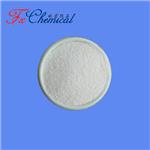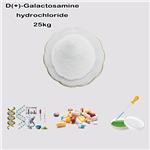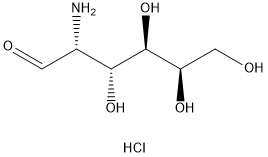D(+)-Galactosamine Hydrochloride: Genotoxicity, Liver Injury Induction, and Osteoarthritis Relevance
D(+)-Galactosamine hydrochloride has been used: as a standard to quantify and express chitin content as glucosamine equivalents; to stimulate cells with glucose in the presence of glucosamine. Glucosamine, an amino sugar, is the precursor of the hexosamine biosynthetic pathway leading to the formation of UDP-N-acetylglucosamine (UDP-GlcNAc), which is then used for making glycosaminoglycans, proteoglycans, and glycolipids. D-(+)-Glucosamine inhibits the coaggregation of Candida yeast species with the bacterial strain S. salivarius.

D(+)-Galactosamine hydrochloride induces genotoxicity
Lipopolysaccharide (LPS) is the main endotoxin constituent of the cell wall of gram-negative bacteria, which is important in endotoxic injury. D(+)-Galactosamine hydrochloride (D-GalN) may be selectively metabolized by the hepatocytes that are deficient in uridine nucleotides, and it may inhibit macromolecule synthesis in hepatocytes. Liver is the main target organ for LPS, and D(+)-Galactosamine hydrochloride significant worsens the fatal consequence of LPS. Therefore, acute co-injection of LPS/D-GalN is a widely used experimental model for acute liver injury (ALI), whilst the long term and low-dose treatment of LPS/D-GalN provokes chronic inflammatory responses that resembles hepatic fibrosis. In fact, ROS may act as the initiator of pro-inflammatory cascades. Previously, a few reports indicated that LPS challenge results in genotoxic effect in different cell lines, including human peripheral blood mononuclear cells, pre-implanting embryonic and uterine cells. Since the combination treatment of LPS/D-GalN may amplify radical production, the genotoxic effect of LPS/D-GalN co-administration needs to be investigated. Here, we hypothesized for a direct link between LPS/ D(+)-Galactosamine hydrochloride exposure and ROS-driven genotoxicity. To address our hypothesis, we then determined the genotoxic potential of LPS/D-GalN in mice, by using the alkaline single cell gel electrophoresis (SCGE) assay to evaluate the integrity of genome (DNA breaks). Both acute and chronic treatment of LPS/D-GalN were applied, since they may represent different pathologic patterns.[1]
LPS is known to mimic the pathophysiology of gram-negative bacterial infections, the combined treatment of LPS and D(+)-Galactosamine hydrochloride is a widely acknowledged hepatic injury model. The results of this study suggest that co-administration of LPS/D-GalN has strong genotoxic effect in mouse liver, as evidenced by a noteworthy increase in tail DNA (%), tail moment and olive tail moment tail moment in the hepatic cells of the exposed mice. Actually, Zhou et al. observed that LPS/D-GalN administration causes apoptotic DNA fragmentation in mouse liver, an evidence for induction of apoptosis which is different from genotoxicity. Our findings are important because they suggest that the combined administration of LPS/ D(+)-Galactosamine hydrochloride may serve as an investigational model for genotoxic study. Up to now there have been several models for chemical-induced liver injury as employed in relevant studies of acute/chronic liver injury, including those using acetaminophen, carbon tetrachloride, retrorsine, Fas ligand, and concanavalin A as hepatotoxicants. Each of these models has its strengths and weaknesses. In this study, acute and chronic challenge of LPS/D-GalN induce genotoxicity in vivo, and the usefulness of this model for relevant genotoxicity studies or as a positive control, is worthy of further investigations.
D(+)-Galactosamine hydrochloride Causes Liver Injury
Pathogenic microorganisms activate the innate immune system and induce non-specific symptoms, including anorexia, changes in body temperature, and reduced food passage rate in the mammalian digestive tract. Hepatic injury is also caused by zymosan, a fungus-derived PAMP. Therefore, rodent models of multiple organ failure have been developed using these PAMPs. Additionally, D(+)-Galactosamine hydrochloride (D-GalN), a well-known hepatotoxic agent, has been frequently used to induce multiple organ failure, because the hepatic injury inducing effects of LPS and zymosan are enhanced by it. Although chickens are infected with microorganisms during their juvenile period, the effects of PAMPs on juvenile chicks have not yet been thoroughly examined. This study aimed to determine the effects of D-GalN, LPS, and zymosan on hepatic injury in chicks. First, we investigated the effects of D-GalN on plasma AST, ALT, and LDH activity. Second, D-GalN was co-injected with LPS or zymosan to determine whether D(+)-Galactosamine hydrochloride cooperatively affected AST, ALT, and LDH activities. Third, the combined effect of D-GalN and LPS or zymosan on the abundance of hepatic thiobarbituric acid reactive substances and superoxide dismutase activity was investigated to assess the involvement of oxidative stress. Finally, the combined effects of D-GalN, LPS, and zymosan on the expression of inflammation-associated genes in the liver were measured.[2]
In rodents, D(+)-Galactosamine hydrochloride-induced oxidative stress contributes to hepatic injury. LPS increases hepatic TBARS levels and decreases SOD activity in rats. In mice, IP injection of zymosan also decreases hepatic SOD activity. Moreover, in mice LPS combined with D-GalN (1 and 300 mg/kg) increased TBARS levels and decreased SOD activity However, chick hepatic TBARS levels and SOD activity were not affected by either D-GalN, LPS, zymosan, or their combination. Therefore, oxidative stress in the chicks was not induced by these treatments. The expression of IL-6 may be used to prevent hepatic injury induced by the combination of D-GalN and LPS. The actual roles of IL-6 and NO in liver injury need to be clarified in future studies. In conclusion, this study showed that D(+)-Galactosamine hydrochloride enhanced the effect of LPS, but not zymosan, and may induce hepatic injury, whereas administration of LPS and zymosan independently had no effect. Our findings suggest that approximately 1-week-old chicks possess tolerance to hepatic injury induced by D-GalN, LPS, and zymosan alone, in contrast to rodents. The differences between chicks and rodents may be due to their age and species, which should be clarified in the future.
Glucosamine hydrochloride for the treatment of osteoarthritis symptoms
Osteoarthritis is the most common arthritis in the world. It affects millions of people with age being the greatest risk factor for developing the disease. The burden of disease will worsen with the aging of the world’s population. The disease causes pain and functional disability. The direct costs of osteoarthritis include hospital and physician visits, medications, and assistive services. The indirect costs include work absences and lost wages. Many studies have sought to find a therapy to relieve pain and reduce disability. D(+)-Galactosamine hydrochloride is one of these therapies. There are limited studies of glucosamine HCl in humans. Although some subjects do report statistically significant improvement in pain and function from products combining glucosamine HCl and other agents, glucosamine HCl by itself appears to offer little benefit to those suffering from osteoarthritis.[3]
References
[1]Dong W, Song E, Song Y. Co-administration of lipopolysaccharide and D-galactosamine induces genotoxicity in mouse liver. Sci Rep. 2021 Jan 18;11(1):1733. doi: 10.1038/s41598-021-81383-5. PMID: 33462304; PMCID: PMC7814041.
[2]Takahashi M, Senga A, Teraoka K, Khan S, Makino R, Cline MA, Tachibana T. D-Galactosamine Causes Liver Injury Synergistically with Lipopolysaccharide but not Zymosan in Chicks. J Poult Sci. 2023 Dec 22;60:2023031. doi: 10.2141/jpsa.2023031. PMID: 38145204; PMCID: PMC10730122.
[3]Fox BA, Stephens MM. Glucosamine hydrochloride for the treatment of osteoarthritis symptoms. Clin Interv Aging. 2007;2(4):599-604. doi: 10.2147/cia.s1632. PMID: 18225460; PMCID: PMC2686334.
You may like
See also
Lastest Price from D(+)-Galactosamine hydrochloride manufacturers

US $0.00/KG2025-08-02
- CAS:
- 1772-03-8
- Min. Order:
- 1KG
- Purity:
- 99%
- Supply Ability:
- 1000kg

US $0.00/kg2025-06-25
- CAS:
- 1772-03-8
- Min. Order:
- 1kg
- Purity:
- 98%min
- Supply Ability:
- 100kg

